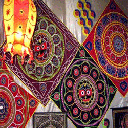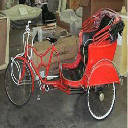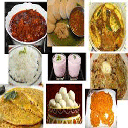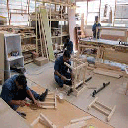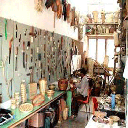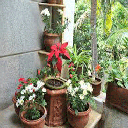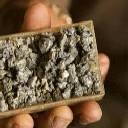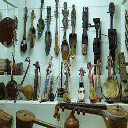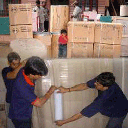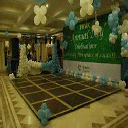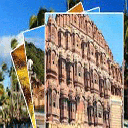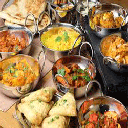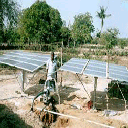Rajathan is the largest state of the Republic of India by area. It encompasses most of the area of the large, inhospitable Great Indian Desert (Thar Desert), which has an edge paralleling the Sutlej-Indus river valley along its border with Pakistan. The state is bordered by Pakistan to the west, Gujarat to the southwest, Madhya Pradesh to the southeast, Uttar Pradesh and Haryana to the northeast and Punjab to the north. Rajasthan covers an area of 132,150 sq mi or 342,239 km². The proportion of the state's total area to the total area of the country is 10.41 per cent. Jaipur is the capital and the largest city of the state. Geographical features include the Thar Desert along north-western Rajasthan and the termination of the Ghaggar River near the archaeological ruins at Kalibanga of the Indus Valley Civilization, which are the oldest in the Indian subcontinent discovered so far. One of the world's oldest mountain ranges, the Aravalli Range, cradles the only hill station of Rajasthan, Mount Abu, famous for Dilwara Temples, a sacred pilgrimage for Jains. Eastern Rajasthan has the world famous Keoladeo National Park near Bharatpur, famous for its bird life and is a World Heritage Site and two famous national tiger reserves, Ranthambore and Sariska Tiger Reserve. Rajasthan was formed on 30 March 1949, when all erstwhile princely states ruled by Rajputs, known as Rajputana, merged into the Dominion of India. Rajasthan means the Land of the Kings. Modern Rajasthan includes most of Rajputana, which comprises mainly the erstwhile Rajput kingdoms as well as two Jat kingdoms and a Muslim kingdom. Marwar (Jodhpur), Bikaner, Mewar (Udaipur), Alwar and Dhundhar (Jaipur) were some of the main Rajput states. The Jats were rulers in Bharatpur and Dholpur. Tonk was ruled by a Muslim Nawab. Rajput families rose to prominence in the 6th century CE. The Rajputs put a very valiant resistance to the Islamic invasions and protected this land with their warfare and chivalry for more than 500 years. They also resisted Mughal incursions into India, but contributed to the slower than anticipated access to the Indian Subcontinent. Later the Mughals, with a technique based on a combination of treachery and skilled warfare were able to set firm a grip on northern India, including Rajasthan. The fighter spirit and valour of Rajputs impressed the Mughals to such an extent that even after defeating the Rajputs, the Mughals held their valour and value in the highest esteem. Mewar led other kingdoms in its resistance to outside rule. Most notably Rana Sanga fought the Battle of Khanua against Babur, the founder of the Mughal empire. Samrat Hem Chandra Vikramaditya, the Hindu Emperor, also known as Hemu in the history of India was born in the village of Machheri in Alwar District in the year 1501. He had won 22 battles against Afghans, from Punjab to Bengal and had defeated Akbar's forces twice at Agra and Delhi in 1556, before acceeding to the throne of Delhi and establishing 'Hindu Raj' in North India, albeit for a short duration, from Purana Quila in Delhi. He was killed in the Second Battle of Panipat. Maharana Pratap Singh, legendary sixteenth century Rajput ruler of Rajasthan. Hawa Mahal or "Palace of Winds" in Jaipur. Maharana Pratap of Mewar resisted Akbar in the famous Battle of Haldighati {1576) and later operated from hilly areas of his kingdom. Bhils were Maharana's main allies during these wars. Most of these attacks were evenly met as the Mughal forces outnumbered Mewar Rajputs in all the wars fought between them. The Haldighati war was fought between 10,000 Mewaris and a 100,000 strong Mughal force (including many Rajputs like Kachwahas from Dhundhar). Over the years the Mughals began to have internal disputes which took their concentration away at times. The Mughal Empire eventually weakened to which several groups across their kingdom saw opportunities to establish their power whilst the army was fighting somewhere else. The Rajputs saw this as an opportunity to reassert their independence. With the decline of the Mughal Empire in the 18th century, Rajputana came under attack by the Marathas and Pindaris, and the Maratha general Scindia captured Ajmer. The Rajput kings following a rapid defeat, concluded treaties with the British in the early 19th century, accepting British sovereignty in return for local autonomy. Following the Mughal tradition as well as its strategic location Ajmer became a province of British India, while the autonomous Rajput states, the Muslim state Tonk, and the Jat states (Bharatpur and Dholpur) were organized into the Rajputana Agency. The Marwaris and Rajasthan's formerly independent kingdom created a rich architectural and cultural heritage, seen even today in their numerous forts and palaces (Mahals and Havelis) which are enriched by features of Muslim and Jain architecture. The development of the frescos in Rajasthan is linked with the history of the Marwaris, who have also played a crucial role in the economic development of the region. Many wealthy families throughout Indian history have links to Marwar. These families include the legendary Birla, Bhandari, Bajaj, Mittal and Mirza families. The main geographic features of Rajasthan are the Thar Desert and the Aravalli Range, which runs through the state from southwest to northeast, almost from one end to the other, for more than 850 km. The northwestern portion of Rajasthan is generally sandy and dry. Most of the region is covered by the Thar Desert, which extends into adjoining portions of Pakistan. The Aravalli Range does not intercept the moisture-giving southwest monsoon winds off the Arabian Sea, as it lies in a direction parallel to that of the coming monsoon winds, leaving the northwestern region in a rain shadow. The Thar Desert is thinly populated; the town of Bikaner is the largest city in the desert. The Northwestern thorn scrub forests lie in a band around the Thar Desert, between the desert and the Aravallis. This region receives less than 400 mm of rain in an average year. Temperatures can exceed 45 °C in the summer months and drop below freezing in the winter. The Godwar, Marwar, and Shekhawati regions lie in the thorn scrub forest zone, along with the city of Jodhpur. The Luni River and its tributaries are the major river system of Godwar and Marwar regions, draining the western slopes of the Aravallis and emptying southwest into the great Rann of Kutch wetland in neighboring Gujarat. This river is saline in the lower reaches and remains potable only up to Balotara in Barmer district. The Ghaggar River, which originates in Haryana, is an intermittent stream that disappears into the sands of the Thar Desert in the northern corner of the state and is seen as a remnant of the primitive Saraswati river. Rajasthan's economy is primarily agricultural and pastoral. Wheat and barley are cultivated over large areas, as are pulses, sugarcane, and oilseeds. Cotton and tobacco are the state's cash crops. Rajasthan is among the largest producers of edible oils in India and the second largest producer of oilseeds. Rajasthan is also the biggest wool-producing state in India and the main opium producer and consumer. There are mainly two crop seasons. The water for irrigation comes from wells and tanks. The Indira Gandhi Canal irrigates northwestern Rajasthan. The main industries are mineral based, agriculture based, and textiles. Rajasthan is the second largest producer of polyester fibre in India. The Bhilwara District produces more cloth than Bhiwandi, Maharashtra and the bhilwara is the largest city in suitings production and export. Several prominent chemical and engineering companies are located in the town of Kota, in southern Rajasthan. Rajasthan is pre-eminent in quarrying and mining in India. Rajasthan had a literacy rate of 67.06% (80.51% male and 52.66% female). Although Rajasthan's literacy rate is below the national average of 74.04% and although its female literacy rate is the lowest in the country (closely followed by Bihar at 53.33%), the state has been praised for its efforts and achievements in raising both male and female literacy rates. Rajasthan has nine universities and more than two hundred and fifty colleges, fifty five thousand primary and seven thousand four hundred secondary schools. There are forty-one engineering colleges with an annual enrollment of about 11,500 students. The state has twenty-three polytechnics and one-hundred and fifty-two Industrial Training Institute (ITIs) that impart vocational training to the students.
Rajasthan Palaces The palaces of Rajasthan are the essence of the heritage of Rajasthan. Serving as the residences of the royal families, these palaces are a perfect blend of Rajput and Mughal architecture. These grand monuments are living reminders of the lifestyle and history of the kings of Rajasthan. These imperial palaces stand not only as independent structures but are even found within several fort complexes. City Palace (Jaipur):Situated amidst the heart of the walled city, City Palace Jaipur was built by Raja Sawai Jai Singh and extensions were made by the successive rulers. A section of the City Palace still serves as the residence of the royal family of Jaipur, though the ground floor and other sections of the palace currently act as museums and are open for public viewing. Hawa Mahal (Jaipur):Hawa Mahal, or The Palace of Winds, is centrally located in Jaipur city and is an unusual structure with 953 small windows at the large wall facing the street, to allow the breeze enter during the hot months of summers. It was built by the poet king Sawai Pratap Singh in 1799 for women of the royal family to view the royal processions on the street below from the palace without being visible themselves. City Palace (Udaipur):Built by Maharana Uday Singh, the founder of the city of Udaipur, City Palace has been continuously extended by successive Maharanas but still retains its uniformity. Standing on the east bank of Lake Pichola, the palace can be entered through Hati pol or the elephant gate which further takes one to the other two gates of the palace, the Tripolia - a triple arched gate and Bari pol - the big gate. Lake Palace (Udaipur):The summer palace of the Maharana of Udaipur, Lake Palace was built by Maharana Jagat Singh in 1743. Originally known as the Jag Niwas, the palace is built over an entire island in Lake Pichola. Umaid Bhawan Palace (Jodhpur):Built in the 20th century, the palace took 15 long years to be completed and is one of the last great palaces to be built in India. The palace derives its name from Maharaja Umaid Singh who was deeply fascinated by western lifestyle and hence, appointed Edwardian Architect, Henry Vaughan Lanchester to build the palace on the Chittar Hills of Jodhpur. Jal Mahal (Jaipur):Situated in the centre of the Man Sagar Lake, the Water Palace of Jaipur was built in the 18th century. Built for royal duck shooting parties, the palace has the scenic Nahargarh hill as its background. The five-storied mahal has nearly four stories submerged in water and is entered through a causeway situated in the middle of the Man Sagar Lake. The palace is now abandoned but looks splendid during monsoons. Lalgarh Palace (Bikaner):Built by Maharaja Ganga Singh in 1902 in the memory of his father Maharaja Lal Singh, this imposing red stone structure is an architectural marvel of Rajasthan. The palace is an example of hybrid architecture combining Mughal, Rajput, and European styles. The exterior of the palace relates the Rajput tale while the interiors of the palace are distinctly oriental. The palace is an example of superb craftsmanship that is evident from the beautiful latticework and filigree work. Sprawling bougainvilleas in the palace garden and peacocks add to the beauty of the palace. The palace has now been turned into a heritage hotel. Patwon Ki Haveli (Jaisalmer):Patwon ki Haveli, or the mansion of the brocade workers, is one of the oldest and most elaborate havelis of Jaisalmer. It has exquisitely carved pillars, corridors, and chambers, and is known for its beautiful jharokhas or balconies. The five-storied haveli is divided into six apartments - two owned by Archaeological Survey of India, two by families who operate crafts shop, and two private homes. Salim Singh Ki Haveli (Jaisalmer):Named after the Prime Minister of Jaisalmer Salim Singh the haveli is nearly 300 years old. The mansion has a beautiful arched roof with superbly carved brackets in the form of peacocks. The front façade of the haveli resembles a ship stern; hence, the haveli is also referred to as the jahaz mahal. Two sandstone tuskers guard the entrance of the haveli. The haveli consists of as many as 38 balconies, all built in distinct styles. Legend has it that the minister wanted to get the haveli built of the same height as that of the palace of the Maharaja but the king did not agree and got the two stories torn down. Nathmlalji Ki Haveli (Jaisalmer):One of the ostentatious and recent haveli of Jaisalmer was built in 1885 AD by the architect brothers Lulu and Hathi. The haveli has a unique story to tell about its construction. The two architect brothers took to left and right size respectively for constructing the haveli, yet the haveli boasts of striking symmetry. Life-size replica of elephants in yellow sandstone guards the entrance of the haveli. The right and left wing of the haveli are adorned by miniature paintings of flora, cattle, and horses. Nawalgarh Havelis (Shekhawati):Referred to as the Open Art Gallery of Rajasthan due to magnificent murals and frescoes from mythology, legendary tales, and contemporary lifestyle adorning them, the havelis of Nawalgarh are a visual treat to the spectators. On the west of the Nawalgarh Fort are a group of havelis, known as aath havelis, depicting the life-size paintings of camel, horses, and elephants. Krishna legends in the form of miniature paintings adorn the walls of Murarka haveli, opposite the aath haveli. To the north is the Hem Raj Kulwal haveli which you can enter through an ornate silver door. Other notable havelis are Bhagton ki Choti Haveli, Parusrampuria Haveli, Dharni Dhakra Haveli, Chhauchharia Haveli, Hira Lal Sarowgi Haveli, and Geevrajka. The interiors of these havelis have a vibrant riot of colors, bewitching you with their beauty. Most of these havelis belonged to the affluent merchant class of the region and truly reflect their ostentatious lifestyle. Mandawa Havelis (Shekhawati):Mandawa havelis are the second Open Art Gallery of Rajasthan, similar to the havelis of Nawalgarh, in terms of beautiful frescoes and murals which add beauty to these havelis. Built in the Jaipur style of architecture, there are pleasant courtyards, gardens, and balconies with splendid views of Mandawa Fort which one can capture from the Mandawa havelis. Displaying the skillful craftsmanship of Rajput artisans is the Goenka Double haveli. The haveli is adorned by life-sized portraits of royal men, traditional Rajasthani women, and religious motifs. The haveli has monumental façade of elephants and horses and has two principal gateways. The Hanuman Prasad Goenka Haveli has religiously inspired frescoes, like Lord Shiva on Nandi and Lord Indra on his elephant. Jhunjhunwala Haveli:Jhunjhunwala Haveli is famous for its intricately carved and painted ceilings and golden leaf painted walls. Paintings of Lord Krishna with the gopis (milkmaids) also adorn the walls. Carved archways, latticed windows, and intricate designs are found in Murmuria haveli as well. Besides traditional frescoes and murals, the Murmuria haveli has modern paintings also, like the one depicting Jawaharlal Nehru with the National Flag on a horseback. Mohanlal Saraf Haveli, Chowkhani Haveli, Bhagchandika Haveli, Gulab Rai Ladia Haveli, Lakshmi Narayan Ladia Haveli, and Newtia Haveli are some other majestic havelis of Mandawa. Fateh Prakash Palace (Udaipur):Located at the shore of Lake Pichola, the palace is named after the great ruler of Mewar, Maharana Fateh Singh who once resided in the palace. The corridors of the palace are adorned by huge paintings of the Mewar style of art which were lavishly patronized between the 17th and 19th centuries. The palace houses one of the most splendid durbar halls of India. The main attraction of the durbar is the huge chandelier in the middle of the hall. There are a number of galleries around the hall for women to view the proceedings in the hall. The durbar is embellished by weapons and life-size paintings of the Maharanas of Mewar. The crystal gallery of the palace has no match to it, housing some unique art pieces. City Palace (Alwar):The palace was built in 1793 AD by Raja Bakhtawar Singh. It is a unique blend of Mughal and Rajput style of architecture. Once the residence for the royalty, the palace has now been converted partly into a district government office while the second floor is transformed into a museum. A marvelous Chattri with Bengali roof and arches, also known as Moosi Maharani ki Chattri, adorns the palace. The entire palace is adorned with lovely artwork. The presence of a picturesque garden Purjan Vihar (Company Garden), laid during the reign of Maharaja Shiva Dan Singh in 1868 AD, adds to the beauty of the palace. It also houses an impressive museum consisting of magnificent antiques. Rajasthan Forts The forts were usually built atop a hill on the outskirts of the city to forbid any enemies from entering the kingdoms of the Rajput rulers. These majestic forts can surprise visitors by their external toughness but intricate and vibrant work by excellent craftsmen in the interiors. The forts of Rajasthan are, without a doubt, the true beholders of the intrigues, wars, and history of the royal houses of Rajasthan. Jaigarh Fort (Jaipur):Jaigarh Fort, also known as the fort of victory, is one of the three hilltop forts that overlook Jaipur. Situated approximately 15 km away from Jaipur, the fort was constructed between 15th and 18th centuries. Amber Fort (Jaipur):Constructed by Raja Man Singh I in 1592 and completed by Raja Sawai Jai Singh I, the fort is a fantastic blend of Mughal and Rajput architecture at its best. Made in red sandstone and white marble, the fort provides the spectators a magnificent sight. Mehrangarh Fort (Jodhpur):Built in 1459 by Rao Jodha and continuously being extended by other rulers of the royal house of Jodhpur till the 19th century, the Mehrangarh Fort is one of the most magnificent and impressive forts of India. Jaisalmer Fort, Sonar Quila (Jaisalmer):The Sonar Quila, or the Golden Fort, is ideally named so in the land of golden sand dunes of Thar Desert in Jaisalmer. Made of yellow sandstone, when the sun rays fall on the fort, it shines like bewitching gold. Kishangarh Fort (Ajmer):Built in 1649 by Maharaja Roop Singh, the fort is named after its ruler and is popularly known as Roopangarh Fort. The nine turreted fortifications encompass within it several battlements, jails, granaries, armories, and foundries. Kumbhalgarh Fort (Udaipur):Constructed in the 15th century by Raja Kumbha, this fort is located 64 km north of Udaipur. Like Chittorgarh, it is one of the significant citadels of Udaipur. Kumbhalgarh Fort is famous for the birth of the legendary Rajput King, Maharana Pratap of Mewar. Nahargarh Fort (Jaipur):Situated atop the rugged terrain of Aravali, the Nahargarh Fort was built by Raja Jai Singh in 1734 while extensions were made to it in 1868. This was the first fort to be built by the kings of Jaipur. The Nahargarh Fort literally means the 'abode of tigers'. Unfortunately, the fort is now almost in ruins due to lack of maintenance, the only well-preserved structure of the fort being Madhavendra Bhawan built by Sawai Ram Singh II which consists of a head suit for the king and twelve identical suits for his queens. At the fort, the visitors witness the actual feel of ancient royalty. Junagarh Fort (Bikaner):Built in 1593 AD by Raja Rai Singh, it is one of the rare forts of Rajasthan which is not built on a hill top. There is a moat encircled around the fort for its defenses. The fort, so far, has remained the unconquered fort of Rajasthan. The fort can be entered only by two main entrances, Karan pol and Suraj pol. The fort complex encompasses several magnificent palaces like, Phool Mahal, Karan Palace, Moon Palace, Ganga Niwas, Anup Mahal, and Rang Mahal or the Palace of Pleasure. Built in red sandstone and marble, the intricate jali work on the balconies, windows, towers, and courtyards is enthralling. The fort also houses a historic temple called Har Mandir and a museum displaying jewels, illuminated manuscripts, treaties, royal farmans, jars, and carpets, giving the onlookers an enriching insight into the royal past. Taragarh Fort (Ajmer-Pushkar):Built in 1345, the fort is situated at the centre of the state of Rajasthan. Taragarh Fort cuddles in the ultimate beauty of nature and is surrounded by picturesque beauty. The fort has six gateways and houses the Miran Saheb ki Dargah within its complex. On the largest rampart of the fort is a famous canon called Bhim Burj. In times of war and siege, the fort acted as a safe haven for people of the city. There are large reservoirs built within the fort that stored water in times of siege. The fort stands erect even today at the Nagpahari hill of Aravali ranges. This fort is one of the amazing examples of bygone architectural beauty. Chittorgarh Fort (Udaipur):The ruined Chittorgarh Fort is an outstanding example of military fortifications. It is situated 157 km from Udaipur and was built in 1440 AD by Raja Kumbha. It is a nine floored structure with seven gates for entrance. Ram pol and Suraj pol are the main entrances to the fort. Legend has it that it was Bhim, the Pandava, who started the construction of Chittorgarh Fort. The entire fort is adorned by sculptures of Hindu gods and goddesses. Within the fort complex are several palaces like the Fateh Prakash Palace, Rana Kumbha Palace, Ratan Singh Palace, and Rani Padmini Palace. In the year 1567 when the Mughal Emperor laid siege on the fort, Raja Udaisingh went into exile and since then, the fort was never resettled. Rajasthan Temples The temples of Rajasthan are exquisitely carved and sculptured and are beautiful structures to view. These holy shrines are said to be found in almost all the cities, towns, and villages of Rajasthan and thus, are deeply a part of the Rajasthani culture. Dilwara Temples (Mount Abu):The example of the most exquisitely carved temples of Rajasthan is, undoubtedly, the Dilwara Jain temples of Mount Abu. This is the principal place of pilgrimage for Jains in India. Built in marble, the Dilwara temples were constructed between the 11th and 13th centuries. Govind Devji Temple (Jaipur):This royal temple, dedicated to Lord Krishna and Goddess Radha, is located in the City Palace complex. It was Raja Sawai Jai Singh who is believed to have brought the image of Govind Devji (Lord Krishna) to Jaipur from Vrindavan. It is a delight to visit the temple on the festival of Janmashthami when the deities are dressed up in all the fineries, accompanied by the enchanting aarti (prayer in singing form) and bhog. The connection one feels with the divine here is the true calling for visitors. Galtaji Temple (Jaipur):Etched in pink hued sandstone, Galtaji is one of the most popular places of pilgrimage in Rajasthan. Dedicated to the Sun God, the temple is also known as the Monkey Temple. The temple was constructed by Diwan Kriparam, an attendant of Raja Sawai Jai Singh II. Housing three holy tanks, people throng to the temple to take a holy dip in the water coming from gaumukh. There are several other temples and holy water springs near the Sun Temple to which ardent devotees visit in large numbers. Birla Lakshmi-Narayan Temple (Jaipur):Constructed by the illustrious Industrialist family of the Birlas, the temple, as the name suggests, is dedicated to Lakshmi Nararyan. Built in pure white marble, the temple is one of the recently constructed temples of Rajasthan. The temple is built on an elevated plain and is surrounded by well manicured gardens. The temple complex houses deities in other small shrines and the walls are adorned by intricate carvings from mythological and religious texts. The temple happens to be one of the major attractions of Jaipur where not only devotees but tourists also turn up in a big way. Brahma Temple (Pushkar):The abode of Lord Brahma and the only temple in the world dedicated to the creator is located in Pushkar. The temple is believed to be dating back to the 14th century and stands on a high plinth with marble steps leading to the inner sanctum. The silver inlaid marble archways and the elaborately carved swans are all a delight to watch. The temple is beautifully adorned with an alluringly carved silver turtle which sits on the floor facing the inner sanctum or the garbhagriha. The turtle is surrounded by hundreds of silver coins with the names of donors engraved on them. Osian Temples (Jodhpur):The desert oasis has nearly 16 Brahmanical and Jain temples which are popular for their intricate carvings and heavy sculpting. The medieval age structures are all in red sandstone with soaring pinnacles, raised pedestals, and pillars. The Sun Temple is the oldest of Osian temples dating back to the 10th century and has carvings similar to that of the Konark Temple. The Sachiyamata Temple, or the Durga Temple, and the Mahavira Temple are the two other prominent temples of Osian. However, most of the temples are now in ruins and require conservation efforts. Eklingji Temple (Udaipur):The chief deity of the Maharanas of Mewar since the time of Bappa Rawal, Eklingji (a form of Shiva deity) is one of the principal pilgrimage destinations in Rajasthan. Having 108 small shrines in marble and red sandstone, the Eklingji temple was built in 734 AD. These shrines are dedicated to Parvati - the wife of Lord Shiva, Ganesh, Kartikeya, the holy rivers Ganga and Yamuna, Amba and Kalka Mata. The main shrine has the Chaumukhi, the qaudriform divinity, the four faced black marble images of Brahma, Vishnu, Maheshwar, and Surya. Shree Nathji Temple-Nathdwara (Udaipur):The Gate of Lord Nathdwara is one of the principal places of pilgrimages for Hindus. The temple of Shree Nathji (Lord Krishna) was built in the 17th century at the spot decided by the lord himself. The idol of Shri Nathji is carved out of a single black marble and has its one arm risen as if it is holding the Govardhan Mountain while the other arm is placed as if it is showering blessings. Legend has it that due to destruction of temples by Mughal Emperor Aurangzeb, the image of Lord Krishna was transferred from Vrindavan and the chariot carrying the image got stuck at the place where the lord wanted the temple to be built. Mehandipur Balaji Temple (Dausa):The temple is a unique marvel as the deity of Mehandipur Balaji Temple is believed to be having divine powers and has the capability of miraculously curing the person possessed by evil spirits. Though medical science does not believe in such cure, still thousands of people throng the temple with nothing but faith, and astonishingly many have been cured of their problems. The temple witnesses thousands of devotees all round the year. Its exclusively impeccable designs and divine mystical powers create an amazing sight. Ranakpur Jain Temples (Udaipur):One of the five holy places of Jains, the Ranakpur temples were created in the 15th century during the reign of Rana Kumbha. The temples are located in the Aravali hill ranges of the Pali district. The main temple is the Chaumukha Temple (four faced temple) dedicated to Adinathji, the 1st Jain tirthankar. The temple has 29 elaborate halls and 1,144 intricately carved pillars which make it an architectural marvel. The other temples in the complex are Parsavnath and Neminath temples with exquisitely sculpted figurines. Karni Mata Temple-Deshnok (Bikaner):The temple, dedicated to a 15th century incarnation of Goddess Durga, is a unique temple as it has thousands of rodents in the temple complex who are worshipped here. With this, the temple has gained popularly as the Rat Temple. The temple entrance has a beautiful marble façade to which huge silver doors were added by Maharaja Ganga Singh. It is considered highly auspicious if a rat, or the holy Kaba as it is known, runs over your feet in the temple. This unusual temple is all decked up during the holy days of Navratri when a major fair is organized here. Rajasthan Wildlife(Park & Sanctuary) Thar Desert, and on the other hand, there are lush green forests and fresh water wetlands. This kind of topography makes Rajasthan a perfect place for diverse flora and fauna. A large number of animals and birds take to living here because of the unpredictable environmental conditions. The dry deciduous forests of Aravalis and wetlands of Bharatpur serve as home to a large number of rare species of birds and animals. Rajasthan is also a haven for some of the endangered species, like the tiger and Blackbuck. Desert National Park (Jaisalmer):Desert National Park of Jaisalmer is a true reflection of the ecosystem and flora and fauna of the Thar Desert. Founded in 1980, it is spread over an area of 3150 sq km and is probably the largest park in India. Due to a minimal leaf cover, the Desert Park supports less of herbivorous animals, camels being an exception to this. Ranthambore National Park:The origin of Ranthambore Wildlife Reserve dates back to 1957, but it was in 1981 that the reserve got its present National Park status. The topography of the park is also diverse which boasts of dry deciduous forests, open grassy meadows, and several rivers and lakes. Sariska Tiger Reserve:This tiger reserve of Rajasthan is spread across 800 sq km approximately and has topography more or less similar to that of Ranthambore. The reserve got its present National Park status in 1979 and became a part of Project Tiger. Bharatpur Bird Sanctuary:The Keoladeo Ghana National Park, situated at Bharatpur, is popularly known as Bharatpur Bird Sanctuary. This world renowned haven for birds had paradoxically been created in 1850 as a duck shooting ground for Maharaja Suraj Mal of Bharatpur. The shallow wetland created by reserving monsoon water in the depression, caused by the confluence of River Gambhir and River Banganga, turned it into a perfect habitat for a large number of birds. It is a haven for over 364 varieties of birds and is one of the most important breeding and feed grounds for birds. In 1982, it got the status of a National Park and in 1985, it was declared a World Heritage site by UNESCO. The park is open throughout the year from sunrise to sunset; however, the best time to visit the sanctuary is during winters since one can find migratory birds flocking from places, like China, Siberia, Turkmenistan, and Afghanistan. Kingfishers, eagles, vulture, storks, white and black necked storks, gappy bills, egrets, herons, and exotic and rare birds like Siberian crane, pelicans, Indian darters, wagtails, robins, and mynahs are commonly sighted here. Though it is principally a bird sanctuary, one can also find animals like sambar, deer, blue bulls, jackals, jungle cats, mongoose, blackbucks, and pythons. Tal Chapper Sanctuary: Tal Chapper Sanctuary lies in the Sujangarh Tehsil of Churu District, situated in the North-eastern part of Rajasthan. It is located on the fringe of the Great Indian Thar Desert and is a haven to one of the rarest species of antelope, the blackbuck. The shallow low lying area and flat tracts, along with small seasonal water ponds, act as a perfect abode to the blackbucks. The sanctuary is nearly 215 km away from Jaipur. Darrah Sanctuary: Spread over an area of about 250 sq km, the Darrah Sanctuary happens to be the erstwhile hunting grounds of the Maharajas of Kota. Situated about 50 km away from Kota, the sanctuary remains closed between the monsoon months of July through September. Nature lovers can throng the sanctuary between February and May. The hill sanctuary is covered with dense forests, including some rare medicinal herbs and trees. Sloth bear, chinkara, leopard, and tiger are the animals which inhabit this sanctuary. Kumbhalgarh Sanctuary :Kumbhalgarh Sanctuary encompasses an area of about 578 sq km and is located in the districts of Udaipur, Pali, and Rajsamand, encircled by the majestic Aravali Hills. The sanctuary derives its name from the impressive historical fort of Kumbhalgarh situated here. This sanctuary, too, is a dwelling for numerous animals, such as the chaisingh (four horned antelope), chinkara, sloth bear, sambar, nilgai, hare, leopard, and hyena. The avian population comprises of the grey jungle fowl, peacocks, dove, mynahs, golden oriole, parakeets, white breasted kingfisher, and red spur owls. Mount Abu Sanctuary: The only hill station of Rajasthan, Mount Abu is rich in floral and faunal biodiversity. It got its current wildlife sanctuary status in 1960. The sub-tropical thorn and sub-tropical evergreen forests consist of 112 kinds of plant families and 820 species. One could spot lions in the jungles of Mt. Abu in the 19th century, while tigers were spotted as late as in the 1970s. The panther has now been declared an endangered species here. The population of sloth bear, however, has been on the rise. Other animals which are found here include hyenas, langurs, civets, jackals, porcupine, hedgehogs, hare, and sambar. Rajasthan Safari This amazing state offers varied safari options for its ultimate exploration. Following the unconventional route by a camel, horse, or jeep safari will get you directly acquainted with the life, culture, people, and traditions of the colorful Rajasthan. Camel Safari:The ship of the desert is going to be the perfect means of getting a feel of the authentic Rajasthan lifestyle. The cities of Jaisalmer and Bikaner - the abodes of a large number of camels and desert landscapes are ideal destinations for enjoying the camel safari. The sight enroute while taking the camel safari is going to be a captivating one. The experience of the village rural life of Rajasthan and the simple lifestyle of the people of Rajasthan is bound to be enthralling. There are private tour operators as well as Rajasthan Tourism Development Cooperation (RTDC) which arrange camel safari rides. One can also tailor the safari according to one's convenience. Jeep Safari:If the camel safari doesn't suit you, a jeep ride is another interesting form of enjoying the safari in Rajasthan. An open jeep is one of the ultimate means of visiting the locales of Rajasthan where one can enjoy the picturesque Thar Desert and marvels of Rajasthan architecture. Besides, it is one of the fastest means of undertaking a safari tour so that one can visit more destinations within Rajasthan. Rajasthan's deserts beckon all adventure lovers with its enthralling jeep safaris. The routes of these safaris basically pass through many quaint villages which bring you more close to its beauty. Horse Safari:The gallant Rajputs took naturally to riding the horse. While in Rajasthan, you can't miss to experience the same royalty. Enters the horse safari, an interesting way to explore the beauty of Rajasthan! It will give your journey an adventurous streak giving you memories to be cherished for lifetime. Horse safaris are one of the most popular ways of exploring the beauty of the sandy rocky terrains. Mounting on the back of the horse is synonymous to tasting the real flavor of the country's erstwhile hospitality and unmatched charm in real ethnic ambience. Horse safaris remain on the top list of favorites all around the year. Elephant Safari:An elephant safari is another option to explore the stupendous royalty of Rajasthan. Though it is not popular in Rajasthan, one can find elephant rides arranged only between Pushkar and Jaipur. The safari, though, gives one a taste of royalty and luxury. It gives an opportunity to the travelers to witness the beautiful views from the top of an elephant which, in itself, is quite thrilling. These elephants are usually ornamented with an umbrella covering, giving you a king-like feel. Elephant safaris also give the travelers a comfortable sitting and marvelous panorama vistas of the fascinating sandy dessert terrain. Rajasthan Desert:Rajasthan is known for its amazing and picturesque small hills of sand dunes and rustic lifestyle. The arid Thar Desert, or the Great Indian Desert, is the world's seventh largest desert and is located in Western India and Southeastern Pakistan. In Pakistan, the land of golden sand dunes is known as Cholistan Desert. Thar Desert is bounded on the northwest by Sutlej River, on the east by Aravalli Range, on the south by salt marshes known as the Rann of Kutch, and on the west by Indus Valley. Spread across 800 km in length and 490 km in width, three-fifth of the desert lies mostly in the state of Rajasthan, but stretches slightly in states of Gujarat, Punjab, and Haryana as well. Sand dunes, dune free plains, and the hills are the three principal landforms of the Thar Desert, which are responsible for its alluring landscape. Rainfall is sparse in the region averaging to 127 to 254 mm annually. The sand dunes in the southern desert region stand as high as 152 m, while the northern region has sand dunes as low as 16 m in height. All these characteristics make this Rajasthan desert the onliest and exclusive site to explore. The temperatures in the region are on extreme with summer temperature soaring as high as 53 °C and winter months dipping to as low as 10 °C or even below. The desert region also has a large number of saline lakes, locally known as dhands. The diversified topography of the desert region has resulted in a rich flora and fauna at Thar. The rich but sparse vegetation includes tree species, small shrubs, and medicinal herbs. On hills, Gum arabic acacia and euphorbia are easily found while Prosopis cineraria tree can be spotted in the plains. The desert is rich in animal and avian population, in fact, some endangered species of the fauna are found nowhere but in Thar region, like the blackbuck, Indian gazelle, Indian wild ass, and the Great Indian Bustard. Sand grouse, ducks, and geese are among the common migratory birds of the desert. This Rajasthan desert simply displays the abundant and unique diversity of nature dwelling in the scorching heat. Agriculture and animal-husbandry are the two principal occupations of the region. However, due to sparse rainfall, agriculture takes a back seat and one finds more number of pastoralists in the region. Hide and wool Industries are also famous in the region. There has been an increase in the number of livestock lately which has led to overgrazing and affected the vegetation of the desert. One of the fast growing industries is eco-tourism which invites large number of populace to visit the sun-kissed Thar Desert, enjoy the Camel safari, and witness the heritage of Jaisalmer. These architectural marvels are a true lifetime experience.


